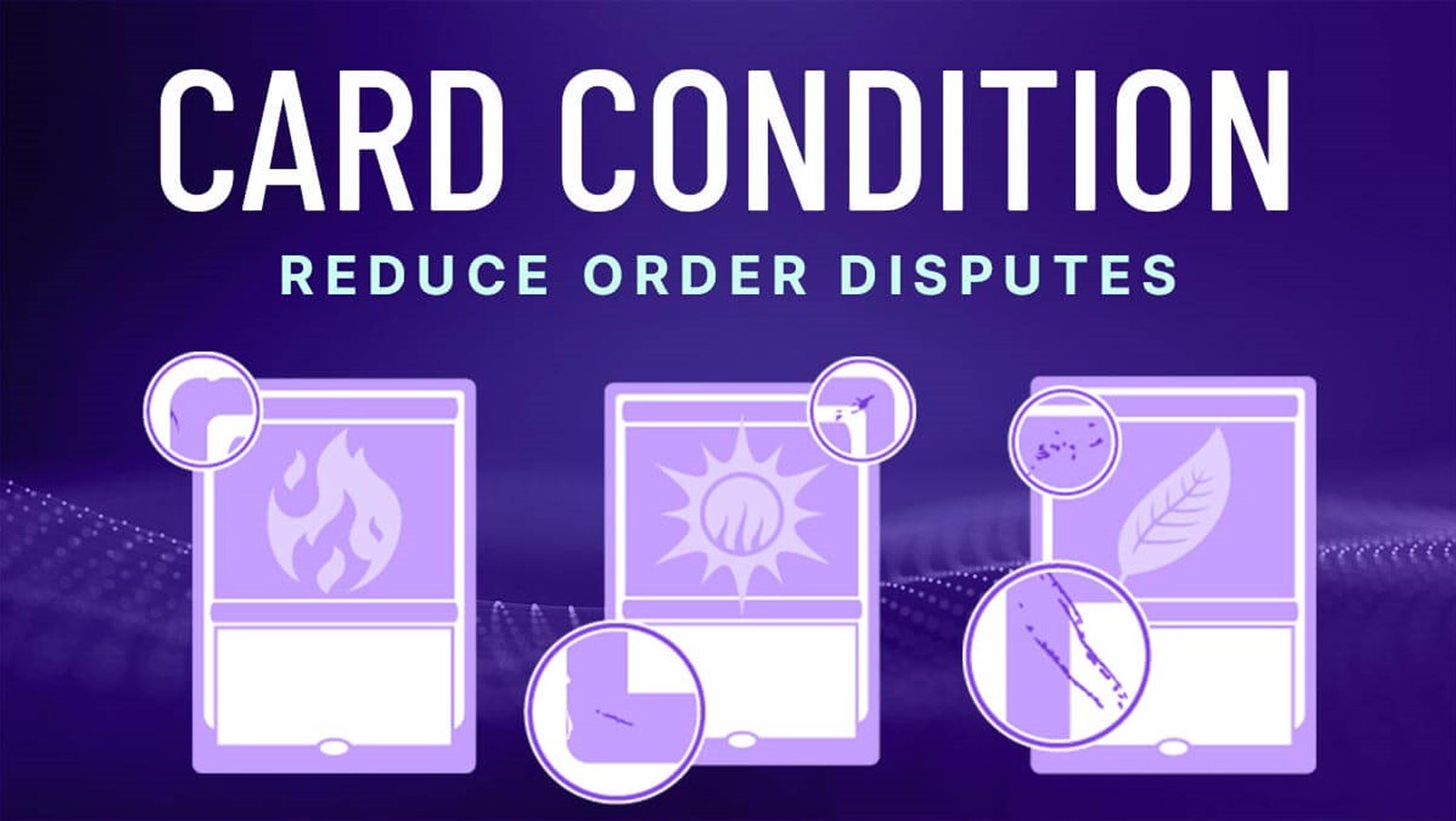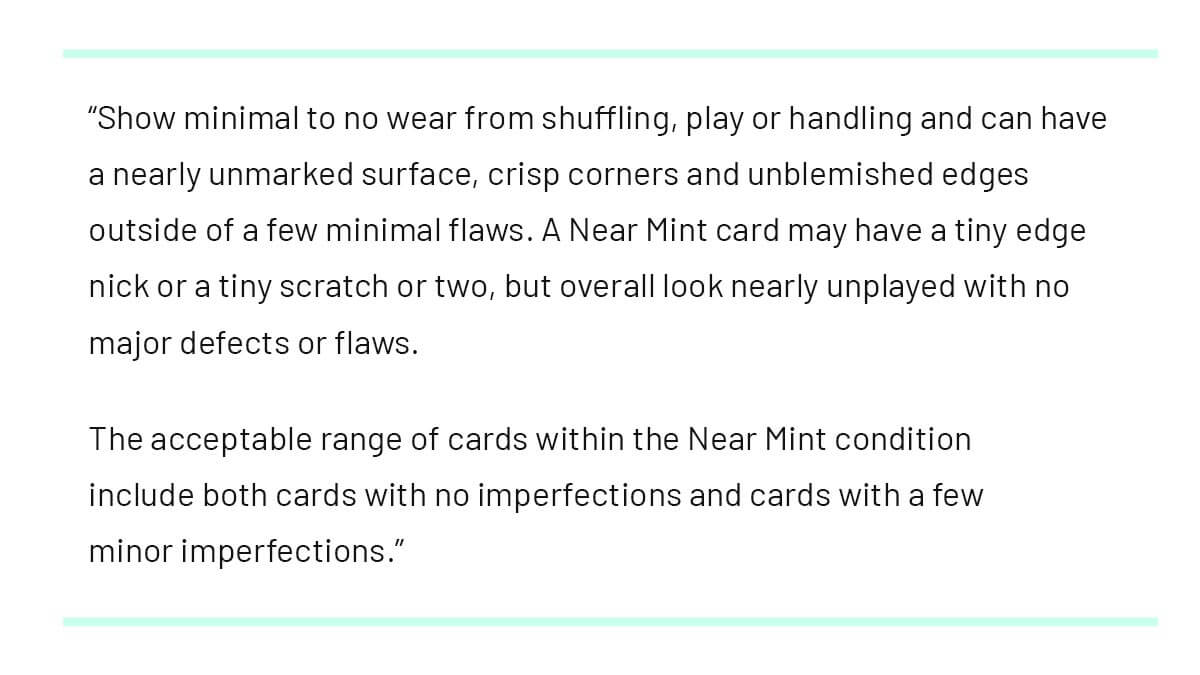Card Condition: Reduce Order Disputes
Megan Burns
Most transactions on TCGplayer happen without any muss or fuss: a seller lists a card using our handy pricing tools and a buyer sees the listing on the marketplace and snags the card. A few business days later their card arrives and they are happy. A few days after that, the seller gets paid - awesome!
Every so often though, a problem will occur with an order, due to either a difference in the buyer’s expectations, damage incurred in transit, or perhaps because of an oversight on the seller’s part. This article aims to walk our sellers through a common buyer complaint: the card(s) they received are not in the condition that the card was listed in.
When receiving a condition complaint, your first thought might be, “Hey, I know that card, I packed it myself and it was in great condition!” That may actually be the case, but unfortunately a lot can happen to a card as it makes its trek through the mail system, and damage, while rare, is not outside the realm of possibility. Another explanation might be that you missed a smudge, or indentation, or a small crease - possibly due to not having a bright enough light source in your workstation or because you had other things on your mind.
Another possibility is that the buyer, not being a professional who works with cards on a daily basis like yourself, has not reviewed our Card Condition Guide or that they have some unrealistic expectations of how a Near Mint card should look. Sometimes buyers are looking for an absolutely pristine card, which generally doesn't exist in the real world, since no matter how much precaution is taken when opening packs and handling cards, there’s still the chance of a small nick or smudge happening here and there. To account for this, our Card Condition Guide defines “Near Mint” as cards that:

As a general rule, it’s best to work from the position that you may have actually made the mistake yourself, even if you are 99.9% sure that you conditioned your card correctly. Starting off on the defensive, and pushing back on the buyer will usually only make the situation more difficult to resolve. Sending along a friendly initial response like this one from our article on Prewritten Responses will keep the buyer’s guard from going up, and will make them easier to work with:
Hello,
We're sorry to hear that your cards arrived in a condition you did not expect!
In general we assess a 10% partial refund per degree of condition difference. Given that the card we sent you was supposed to be ____________________ and you found it is ____________________, we would be happy to provide you with a partial refund of ____________________ of the value.
If this is acceptable, please let us know and we will take care of that partial refund right away,
Alternatively, If you would rather receive a full refund by returning the card, just let us know and we will send a postage paid return mailer to you. Once we receive the card back at our store we will then process the full refund.
Please let us know if one of these options would be acceptable and we'll take care of this unfortunate issue immediately. Our apologies for the error.
Starting with the offer of a partial refund can save you some time and money by avoiding having to send a prepaid mailer as outlined in our Refund and Return Policy For Delivered Singles. Some buyers will be satisfied with a small refund to reflect the difference in condition. Unless you’re dealing with an extremely rare card, or an alternate printing, in which case the buyer may insist on a return.
When resolving Direct by TCGplayer orders, our customer service team uses the rule of thumb outlined above: if we do not have a price point to compare to, like an actual listing for the card at the next condition down on the marketplace, we offer a 10% refund for each step down in condition. So, if you sent a NM card, and the buyer claims it is LP, then you could start off with an offer of a 10% refund. If the card was sent as NM and the buyer says it’s MP, then a 20% refund would make sense, and so on.
If the buyer does not want a partial refund, then the next step will be to offer to send the buyer a prepaid mailer to retrieve the card in question. Some sellers have a threshold in mind for cards that they are willing to write off. For most sellers it probably doesn’t make fiscal sense to send a mailer to retrieve a 25 cent card that is in dispute, so they will just refund the card in its entirety and call it a day. But if the card is more valuable and you want to get it back to relist and recoup your costs then you’ll just want to send along a prepaid mailer as described above, using our Shipping Guidelines to ensure that the card will be well protected on its way back to you. If the card is particularly valuable and this is a domestic order, you’ll also want to have tracking for the return mailer itself, so that we can cover you in the event that the card goes missing in the mail.
If you’d like to “save the sale” and send along a replacement copy (and the buyer prefers a new copy as opposed to a full refund) you can also send that copy in the package containing your prepaid mailer and the buyer can pop the disputed card in the return mailer and have their replacement delivered at the same time. This way you don’t have to issue a refund, the buyer is happy, and you can relist the returned card if you wish.
Once the card makes its way back to you, just go ahead and issue a full refund (if the buyer did not want a replacement) to the buyer and you can then check the card out and see if you need to reevaluate your initial condition that you assigned and relist it at a lower condition, or if the card looks good enough to you, you can just relist as normal and chalk it up to the buyer not having a perfect grasp of our Condition Guide.
After the entire dispute has been handled, if you feel that the buyer may have been dishonest, or that you’re concerned that they might be having a lot of condition issues (or if this is a name you’ve seen before and you’ve encountered similar order disputes with them) you can always use the “Escalate This Thread” button within the message you have open with your buyer and fill in any relevant details. Alternatively, you can fill out our help request form here. Once we receive your escalation, our Customer Service team will review the order, the messages, and the buyer and check to see if there is a pattern of condition complaints. If we determine that the buyer is behaving in bad faith, we will lock or terminate their account so that they can’t continue to cause trouble for sellers.
As always, if you have questions for our Customer Service team at any point during this process, you can send us a message using the methods above and we can step in before the issue has been fully resolved. Sometimes there will be some unique quirks to the scenario that you haven’t encountered before so our team will be able to guide you through to the best resolution for both the buyer and you, the seller.
If you follow all the steps above and maintain a friendly and helpful tone throughout your interaction with the buyer then you should be able to quickly resolve the dispute and get back to listing and shipping and best of all: making money!
